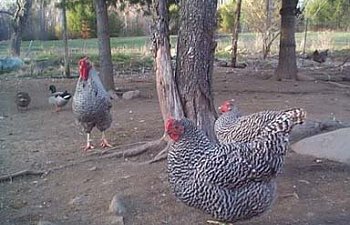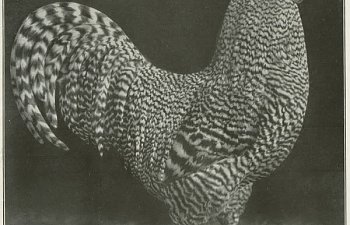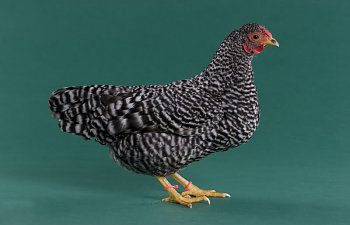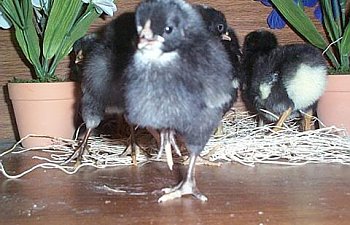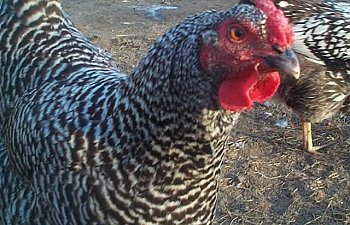The American Dominique
The Dominique is a very versatile breed, being valued on the small farm or homestead for both eggs and meat. They are excellent foragers if allowed to free range, and their cuckoo barring gives them an advantage against predators, as it is excellent camouflage.
Dominique hens lay a medium to large sized brown egg. If allowed to set their own eggs, they will often go broody and make excellent mothers.
Dominique Chickens have endured a long and rich history. First developed by the Colonists, they were not recognized as a specific breed until the early 1800's.
They steadily lost popularity as Asiatic breeds became the norm on American farms, and were almost extinct by the early 1900's. The National American Dominique Club was founded to help boost their popularity, but folded in the 1930's.
After facing another near extinction by the 1970's, Dominiques began to again regain popularity and more people sought to add these wonderful birds to their farms and breeding programs. In the past few years however, their popularity has again waned, and many folks have moved on to other breeds.
The Dominique Club of America was founded in 1973 to help promote the breed and serve as a source of information and breeding stock for members working on their own strain. For more information on the DCA, visit their website here .
Dominique vs. Barred Rock
The most noticeable difference between the two breeds is the comb. The Dominique sports a rose comb, which has an upturned spike, while the Barred Rock has a single comb.
Another major difference is the coloring and barring. Correct Dominique barring is not quite black on not quite white, and the bars are staggered, rather than the parallel and sharply contrasting black and white barring of the Barred Rock.
The Dominique cock has a longer, flowing tail and U-shaped back than that of the Barred Rock cock, and the Dominique hen is more refined, with a longer neck and back which slopes downward to the tail. The overall carriage of the Dominique is more upright than the Barred Rock.
Standard
The Standard of Perfection lists the standard weight of a Dominique cock is 7 lbs, while the standard weight of a hen is 5-5.5 lbs.
Both sexes should have a medium sized head, neck carried well up, with a short, stout beak. A rose comb should be compact, firm and straight on the head, free from hollows, and ending in an upward curving spike. The neck should be of medium length, gracefully arched, and the back should be of medium length and breadth, rising with a concave sweep to the tail. The tail of the cock should be carried at 40 degrees from the horizontal. Full, round and prominent breast, moderately long thighs, with shanks fine in bone and medium length toes. Shanks and toes should be yellow in color and free from feathers and stubs.
The Large Fowl Dominique falls under the "American" class, while the Bantam variety is in the "Rose Comb Clean Leg" class.
Status
Currently, the American Livestock Breeds Conservancy lists the Dominique as being on "watch" status. They have enjoyed a resurgence of popularity and their numbers are slowly climbing. Dominiques have the honor of being one of the breeds listed on the Slow Food USA Ark of Good Taste.
The Dominique is a very versatile breed, being valued on the small farm or homestead for both eggs and meat. They are excellent foragers if allowed to free range, and their cuckoo barring gives them an advantage against predators, as it is excellent camouflage.
Dominique hens lay a medium to large sized brown egg. If allowed to set their own eggs, they will often go broody and make excellent mothers.
History Dominique Chickens have endured a long and rich history. First developed by the Colonists, they were not recognized as a specific breed until the early 1800's.
They steadily lost popularity as Asiatic breeds became the norm on American farms, and were almost extinct by the early 1900's. The National American Dominique Club was founded to help boost their popularity, but folded in the 1930's.
After facing another near extinction by the 1970's, Dominiques began to again regain popularity and more people sought to add these wonderful birds to their farms and breeding programs. In the past few years however, their popularity has again waned, and many folks have moved on to other breeds.
The Dominique Club of America was founded in 1973 to help promote the breed and serve as a source of information and breeding stock for members working on their own strain. For more information on the DCA, visit their website here .
Dominique vs. Barred Rock
The most noticeable difference between the two breeds is the comb. The Dominique sports a rose comb, which has an upturned spike, while the Barred Rock has a single comb.
Another major difference is the coloring and barring. Correct Dominique barring is not quite black on not quite white, and the bars are staggered, rather than the parallel and sharply contrasting black and white barring of the Barred Rock.
The Dominique cock has a longer, flowing tail and U-shaped back than that of the Barred Rock cock, and the Dominique hen is more refined, with a longer neck and back which slopes downward to the tail. The overall carriage of the Dominique is more upright than the Barred Rock.
Standard
The Standard of Perfection lists the standard weight of a Dominique cock is 7 lbs, while the standard weight of a hen is 5-5.5 lbs.
Both sexes should have a medium sized head, neck carried well up, with a short, stout beak. A rose comb should be compact, firm and straight on the head, free from hollows, and ending in an upward curving spike. The neck should be of medium length, gracefully arched, and the back should be of medium length and breadth, rising with a concave sweep to the tail. The tail of the cock should be carried at 40 degrees from the horizontal. Full, round and prominent breast, moderately long thighs, with shanks fine in bone and medium length toes. Shanks and toes should be yellow in color and free from feathers and stubs.
The Large Fowl Dominique falls under the "American" class, while the Bantam variety is in the "Rose Comb Clean Leg" class.
Bantam Dominique hen
Dominique chicks are sex linked, which makes it much easier for breeders to sex their chicks as soon as they hatch. A cockerel chick has a light and scattered spot of yellow on the top of the head, while the head spot of a pullet chicks is more compact and solid. Also, the shanks & feet of a pullet chick is darker and much more shadowed than that of a cockerel chick.
Currently, the American Livestock Breeds Conservancy lists the Dominique as being on "watch" status. They have enjoyed a resurgence of popularity and their numbers are slowly climbing. Dominiques have the honor of being one of the breeds listed on the Slow Food USA Ark of Good Taste.

